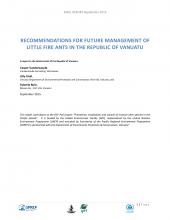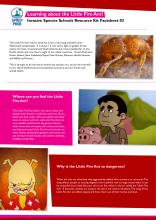Quantifying the dominance of little fire ant (wasmannia auropunctata) and its effect on crops in the Solomon islands

BRB
Available Online
Introduced most probably intentionally, as a biological control against nut fall bugs (Amblypelta sp) in coconut and cocoa, the Little Fire Ant (Wasmannia auropunctata) has for more than 30 years continued to spread and colonies a number of different environments in the Solomon Islands. To date, no studies have investigated the ecological impact of these ants. The impact of Little Fire Ants was measured on (1) the overall ant fauna within subsistence gardens, (2) the prevalence of additional insect pests in subsistence gardens, and (3) the significant pest Tarophagus sp. of one crop - taro and its natural predator Cyrtohinus fulvous. Ant fauna was surveyed on two study areas in garden sites of four common subsistence crops: potato, cassava, taro and yam; a total of 36 gardens per study area with three trials per garden, using baiting and hand collecting. The existence of insect pests that form a relationship with W. auropunctata was measured in the same gardens by standardized visual searches, plus some identification and collecting from randomly selected crop within the gardens. The impact of W. auropunctata on the significant taro pest Tarophagus sp. and its natural predator Cyrtohinus fulvous was measured in 56 taro gardens with half of the gardens infested with Little Fire Ants. Twenty five taro plants were randomly selected in each taro garden and sampled using standardized visual identification. Sites with W. auropunctata had significantly lower mean abundance of other ant species than gardens free of W. auropunctata. A number of hemipteran insects (most of them pests) were also observed to have developed relationships with W. auropunctata. Although there was no significant difference in the mean population density of C. fulvous per taro plant between taro plants infested and free of W. auropunctata, significantly more Tarophagus were found on taro plants in the presence of W. auropunctata than in the absence of W. auropunctata. Three conclusions are drawn here, (1) the presence of W. auropunctata leads to a reduction in the ant fauna at a site, and is likely to lead to ecological damage to other invertebrates and vertebrates, (2) the presence of W. auropunctata in the subsistence crops may have lead to the development of harmful relationships between hemipteran pests and W. auropunctata, and (3) the presence and dominance of W. auropunctata on subsistence crops may provide an environment that i allows insect pests to thrive. Little Fire Ants therefore pose an economic as well as an ecological risk in subsistence gardens in the Solomon Islands



